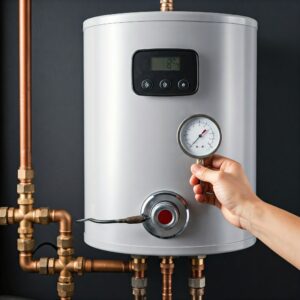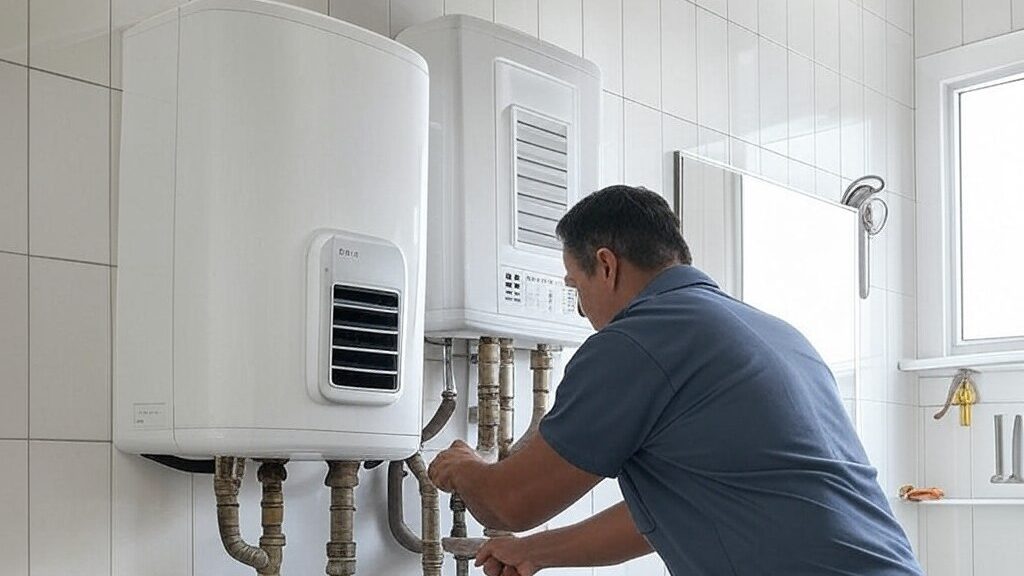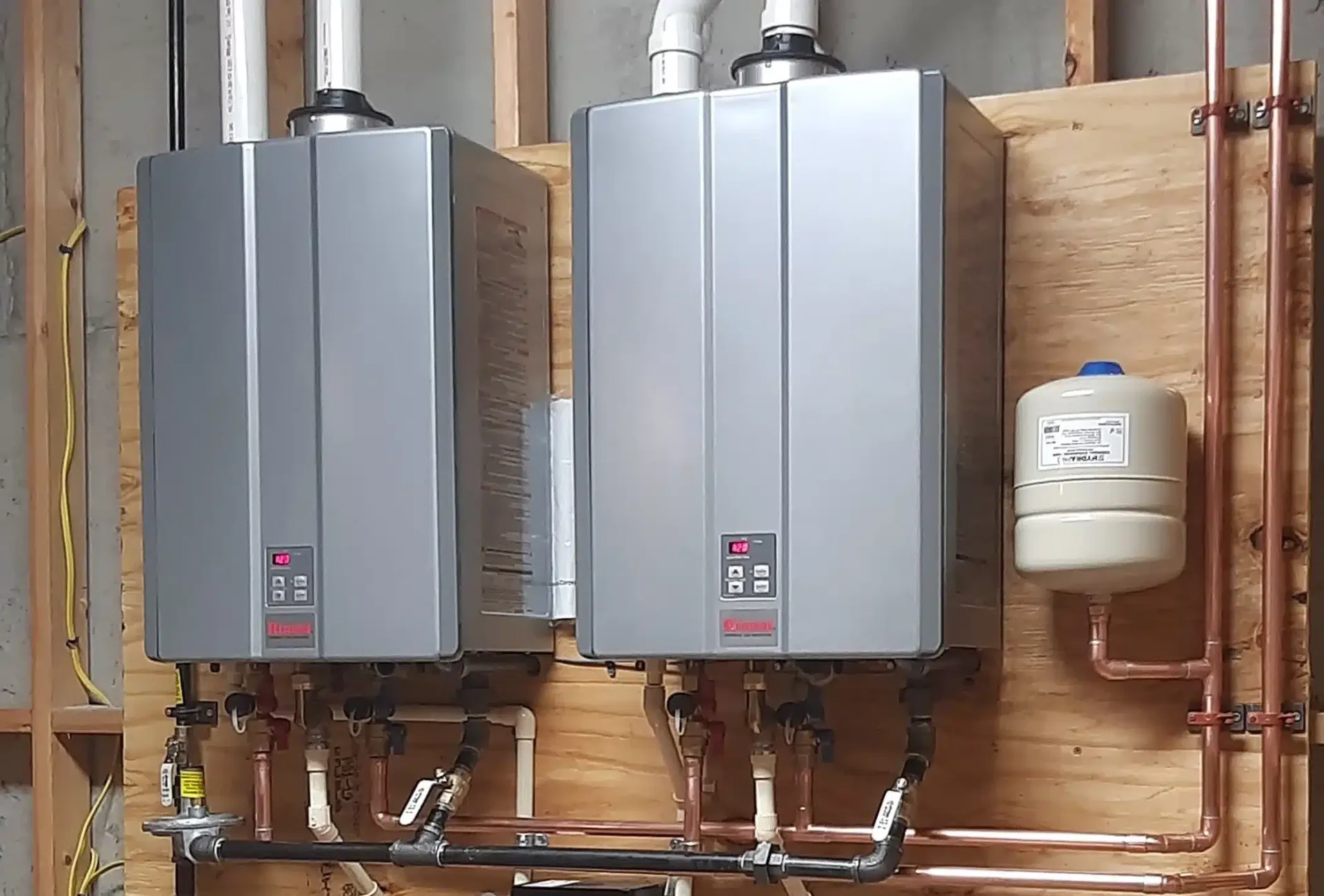Your home’s tankless water heater can cut energy usage by up to 34% when you use 41 gallons or less of hot water daily. The average American household pays $268 every year just to heat water, which makes this efficiency boost even more valuable.
On top of that, these smart systems work for 20-30 years – twice as long as regular storage tanks. Tankless electric models turn almost all electricity into usable heat with a 99% thermal efficiency rating. You’ll find these units are a great way to get both environmental and financial benefits, with yearly savings reaching $108 for gas-fired models and $44 for electric ones.
This piece will show you how tankless water heaters work, what efficiency ratings mean, and what you should know about costs before switching to endless hot water.
Understanding Tankless Water Heater Technology
A tankless water heater works on a simple principle: it heats water only when you just need it. These systems start working as soon as you turn on your hot water tap, unlike traditional storage tanks.
How tankless systems heat water on demand
Your tankless water heater starts when cold water flows into the unit. A flow sensor detects this and signals the control panel to start heating [1]. The system then fires up a gas burner or electric elements to warm the water as it moves through the heat exchanger. Your unit can deliver hot water at 2 to 5 gallons per minute, based on its capacity [2].
Key components and their functions
Several vital components work together in your tankless system:
| Component | Function |
|---|---|
| Flow Sensor | Detects water entry and activates heating [3] |
| Control Panel | Manages temperature and coordinates system operations [3] |
| Heat Exchanger | Transfers heat to water through specialized coils [4] |
| Mixing Valve | Regulates final water temperature [3] |
| Temperature Sensor | Monitors and adjusts heating for consistent output [3] |
Different types of tankless water heaters
You can choose from these tankless water heater categories:
- By Technology:
- Non-condensing units: Use a single heat exchanger and just need stainless steel venting [1]
- Condensing units: Use multiple heat exchangers and capture exhaust heat to work better [1]
- Hybrid systems: Include a small buffer tank that improves performance [4]
- By Fuel Source: Electric tankless water heaters use copper heating elements and can reach up to 98% energy efficiency [5]. These units are nowhere near the size of gas models and need minimal maintenance [5].
Gas-powered units can deliver higher flow rates between 5 to 10 gallons per minute [6]. These units are affordable in areas with lower natural gas prices, but they just need yearly professional maintenance [5].
Point-of-use tankless water heaters are a great solution for smaller applications. These compact units fit inside cabinets or closets and provide dedicated hot water to specific fixtures [1]. They work best especially when you have remote bathrooms or appliances far from your main water heater.
Measuring Tankless Water Heater Efficiency
Understanding how efficiency works is the first step to getting the best performance from your tankless water heater. The Department of Energy uses a standardized metric called the Uniform Energy Factor (UEF) to rate water heater efficiency [7].
Energy factor ratings explained
The UEF rating of your tankless water heater shows how well it turns energy into hot water. Modern tankless systems are impressive with UEF ratings of 0.85 to 0.96 [8]. These numbers beat traditional tank heaters that only reach between 0.54 and 0.72 UEF [8].
Let’s look at efficiency ratings for different types:
| Type | Typical UEF Range |
|---|---|
| Gas Condensing Tankless | 0.90-0.96 |
| Non-Condensing Tankless | 0.80-0.82 |
| Traditional Tank | 0.54-0.72 |
Real-life efficiency metrics
Your home’s actual energy savings might not match lab ratings. Homes using 41 gallons or less of hot water daily see 24-34% better energy efficiency [9]. Homes with higher usage (around 86 gallons per day) still benefit from 8-14% improvements [9].
Factors affecting performance
These elements affect your tankless water heater’s efficiency:
- Water Quality Effect: Hard water minerals can reduce efficiency as time passes [10]
- Flow Rate: Your system delivers hot water at 2-5 gallons per minute, and gas units give higher flow rates [11]
- Temperature Settings: The needed heat rise affects overall performance
- Maintenance Schedule: Regular cleaning stops efficiency loss from mineral buildup [10]
The right size is vital for the best performance. Your home might need parallel units if multiple people use hot water at once [11]. Some homeowners choose separate heaters for different appliances to keep peak efficiency [11].
Condensing tankless water heaters run 30% more efficiently than standard tank models [12]. These savings come from eliminating standby heat loss that happens when traditional tanks keep water hot all the time [12].
Calculating Energy Savings and Costs
The switch to a tankless water heater needs careful financial thinking. These systems deliver impressive efficiency. You should understand both short-term costs and long-term benefits to make a smart choice.
Original Investment Costs
A tankless water heater’s upfront cost ranges between $1,000 and $3,000 for just the unit [13]. Your installation costs will vary based on fuel type:
| Fuel Type | Installation Cost Range |
|---|---|
| Electric | $300 – $1,500 [13] |
| Gas | $500 – $2,500 [13] |
| Propane | $600 – $3,500 [14] |
Monthly Energy Savings
The numbers tell an interesting story about potential savings through monthly usage patterns. Homes using 41 gallons or less of hot water daily see 24% to 34% better energy efficiency [9]. Households that use around 86 gallons per day typically see improvements of 8% to 14% [9].
Your monthly savings depend on:
- Daily hot water usage patterns
- Local utility rates
- System maintenance needs
- Seasonal temperature changes
Long-term Financial Benefits
Your tankless water heater investment pays off through several ways. The Department of Energy shows that gas-fired tankless units save homeowners about $100 each year. Electric models cut costs by roughly $44 annually [15].
The value grows when you realize these systems last more than 20 years [9]. This lifespan doubles that of traditional tank heaters, which need replacement after 10-15 years [9].
Here’s how to figure out your return on investment:
- Compare current costs with projected tankless operation expenses to estimate yearly savings
- Calculate net annual benefits by subtracting installation costs from yearly savings
- Find your break-even point by dividing total installation cost by net annual savings [16]
Regular maintenance plays a significant role in maximizing these benefits. The original investment might get pricey, but installing a tankless water heater at each hot water outlet could boost your energy savings to 27-50% [15]. This approach offers the best chance for long-term cost reduction, despite higher upfront costs.

Installation Requirements and Considerations
The right installation of a tankless water heater needs proper planning and several vital factors. A good understanding of these requirements will help you get the best performance and safety.
Home compatibility assessment
The existing infrastructure in your home determines installation feasibility. Tankless water heaters need specific ventilation systems – either direct venting that sends exhaust outside through a wall or power venting with a motorized fan [17]. Space constraints might create unexpected challenges. You’ll need enough clearance to ventilate properly and access utility connections [17].
The home assessment should look at:
- Ventilation requirements and existing infrastructure
- Available space to place the unit and access maintenance
- Current plumbing configuration
- Local building codes and permit requirements
Electrical and gas requirements
The utility requirements of your tankless water heater depend on the type you select:
| Requirement Type | Gas Units | Electric Units |
|---|---|---|
| Gas Line Size | 3/4 inch minimum [18] | N/A |
| Electrical Service | 120V for controls [19] | 150-200 amp service [2] |
| Venting Material | Category III stainless steel [19] | Not required |
Gas units might need an upgraded gas line. These systems use 150k to 199k BTUs compared to traditional tanks that use 35k-65k BTUs [20]. Electric models need substantial electrical capacity with dedicated circuits and a possible service upgrade [2].

Professional vs DIY installation
DIY installation might seem affordable, but professional installation provides several benefits:
- Safety Assurance
- Proper handling of gas/electrical connections
- Correct venting installation
- Code compliance verification [4]
- Warranty Protection
- Many manufacturers require professional installation
- Maintains warranty validity
- Documentation of proper installation [4]
Professional installation costs range from $500-$2,500 [20]. The price varies based on fuel type and existing infrastructure. DIY installation requires advanced plumbing and electrical skills [21].
Professional installers help you:
- Get an accurate assessment of your home’s compatibility
- Handle necessary permit requirements
- Ensure proper sizing and placement
- Complete installation quickly [4]
Gas-powered units might need a gas line upgrade that adds $500-$2,000 to the project cost [20]. Electric units typically need 125 amps to work effectively, which might require electrical panel upgrades [20].
Maximizing Tankless Water Heater Performance
Your tankless water heater works best when you size and optimize it correctly. The right strategies will help you get consistent hot water while keeping efficiency high.
Optimal sizing for your needs
Two main factors determine the right size for your tankless water heater: flow rate and temperature rise. Your system should achieve at least a 70-degree temperature rise [22]. Here’s a practical guide that shows sizing based on simultaneous hot water usage:
| Household Usage | Required Flow Rate |
|---|---|
| 1-2 fixtures | 3.5 GPM |
| 2-3 fixtures | 5.0 GPM |
| 3-4 fixtures | 7.0 GPM |
These requirements change based on your specific needs. You might want to install multiple units if your household uses several hot water applications at once [9]. A shower and dishwasher running together could push a single unit to its limits.
Temperature control strategies
The right temperature setting is vital for comfort and efficiency. The Consumer Product Safety Commission suggests keeping your tankless water heater at 120°F [23]. This temperature offers several benefits:
- Prevents scalding risks
- Minimizes mineral buildup
- Reduces energy consumption
- Extends equipment lifespan
Your tankless system’s LED panel lets you adjust temperature precisely [24]. Lower temperature settings can save you energy, as each 10°F reduction cuts energy costs by 3-5% [25].
Flow rate optimization
Your water heater’s flow rate affects its performance directly. These systems deliver hot water at 2-5 gallons per minute, and gas-fired units offer higher flow rates [9].
Your system works best when you:
- Calculate your peak demand
- List all fixtures used simultaneously
- Add up their individual flow rates
- Think about seasonal temperature changes
- Make it work better
- Install low-flow fixtures
- Space out high-demand activities
- Keep an eye on water pressure
Point-of-use heaters work great for distant fixtures [9]. They cut down wait times and make the whole system more efficient. Homes with high hot water needs might benefit from multiple units working together rather than one big unit.
Your household’s usage patterns help set the right flow rates. A home that needs hot water for multiple showers, laundry, and dishwashing at once needs a system that handles at least 8.5 GPM [26]. The right balance between capacity and demand prevents temperature swings and low water pressure.
Regular maintenance keeps your flow rates optimal. Professional inspections can spot issues early [3]. Hard water areas might benefit from a water softener that prevents mineral buildup and keeps efficiency high over time.

Maintenance and Longevity
Regular maintenance is the life-blood of your tankless water heater’s longevity and performance. A proactive approach will help you avoid getting pricey repairs and keep operations consistent, instead of waiting for problems to surface.
Regular maintenance schedule
Your tankless water heater needs systematic care to stay efficient. Here’s the essential maintenance timeline to follow throughout the year:
| Maintenance Task | Frequency | Type |
|---|---|---|
| Filter Cleaning | Every 4 months | DIY/Professional |
| System Flushing | Annually/Bi-annually | Professional |
| Descaling | Annually | Professional |
| Component Inspection | Annually | Professional |
We noticed that homes with hard water need more frequent maintenance, sometimes bi-annual servicing [27]. A water softener installation can help minimize corrosive lime and mineral buildup [28].
Common issues and solutions
Your tankless system might face several challenges affecting its performance:
- Mineral Buildup
- Temperature Fluctuations
- Often related to water pressure or thermostat issues [1]
- Solution: Check water pressure and thermostat settings
- Ignition Problems
- Usually linked to gas supply or electrical issues [1]
- Solution: Verify gas levels and electrical connections
Modern tankless water heaters come with built-in error codes that help troubleshoot problems [30]. These codes can speed up diagnosis and resolution when you know how to read them.
Extending system lifespan
Your tankless water heater can last between 15-20 years with proper care [31]. Several factors influence its longevity:
- Water Quality Management
- Professional Maintenance
- Annual inspections catch potential issues early [28]
- Professional descaling removes mineral deposits
- Component checks ensure optimal performance
- Temperature Optimization
- Set temperature to 120°F for optimal operation [32]
- Avoid excessive temperature settings that strain the system
- Monitor seasonal adjustments as needed
You might notice decreased performance or unusual sounds. Quick response to these signs prevents more serious issues. Professional maintenance checks pipes, pressure relief valves, air intake filters, and tests temperature [31].
Basic tasks like cleaning the inlet water filter and air intake filter are suitable for DIY maintenance [28]. Using a certified technician saves time and protects your warranty [28]. Costs vary based on unit size, accessibility, regional water quality, and local labor rates [28].
Note that skipping proper maintenance leads to several problems:
- Reduced efficiency due to mineral deposits on the heat exchanger
- Decreased water flow from mineral buildup in pipes and filters
- Shortened service life
- Potential warranty issues [28]
The regular flushing process uses a pump to circulate cleaning solution, followed by thorough rinsing [29]. This takes about 45 minutes to an hour and needs professional handling unless you’re comfortable with DIY maintenance [29].
Conclusion
Tankless water heaters are a smart investment for homeowners who want energy efficiency and reliable hot water. These systems deliver impressive energy savings – up to 34% for households using 41 gallons or less daily and last twice as long as traditional tanks.
Original costs range between $1,000 and $3,000, but the long-term benefits make tankless systems worth it. Gas-fired units save about $100 annually, while electric models cut costs by $44 per year. On top of that, the right sizing and regular maintenance will give optimal performance throughout their 20-30 year lifespan.
Your tankless water heater’s success relies on three core factors: professional installation, consistent maintenance, and the right size for your household’s needs. Professional installation protects your warranty and keeps you safe, while annual maintenance stops mineral buildup from reducing efficiency. The right size unit based on your peak hot water demands means reliable performance when you need it most.
Note that tankless water heaters perform best when they match your specific usage patterns and receive proper maintenance based on manufacturer guidelines. With careful planning and regular upkeep, your tankless system will deliver efficient, endless hot water for decades.
FAQs
Q1. What are the main advantages of a tankless water heater? Tankless water heaters offer significant energy savings, potentially up to 34% for households using 41 gallons or less of hot water daily. They also provide endless hot water on demand and have a longer lifespan of 20-30 years compared to traditional tank heaters.
Q2. How much does a tankless water heater cost to install? The initial cost for a tankless water heater unit typically ranges from $1,000 to $3,000. Installation costs vary depending on the fuel type, with electric units costing $300-$1,500 to install, gas units $500-$2,500, and propane units $600-$3,500.
Q3. What maintenance does a tankless water heater require? Regular maintenance includes cleaning the filter every 4 months, annual system flushing and descaling, and component inspection. Homes with hard water may need more frequent servicing. Professional maintenance is recommended to ensure optimal performance and protect the warranty.
Q4. Can a tankless water heater handle multiple hot water demands simultaneously? Tankless water heaters can handle multiple demands, but it depends on the unit’s flow rate capacity. For households frequently using several hot water applications simultaneously, installing multiple units or choosing a higher capacity model may be necessary to meet peak demands.
Q5. How long do tankless water heaters typically last? With proper care and maintenance, tankless water heaters can last between 15-20 years, which is about twice the lifespan of traditional tank water heaters. Regular maintenance, water quality management, and appropriate temperature settings can help extend the system’s longevity.
References
[1] – https://www.austingsmechanical.com/blog/troubleshooting-tankless-water-heater-problems
[2] – https://www.ecosmartus.com/support/electrical-requirements
[3] – https://www.mhiplumbers.com/5-tips-to-optimize-your-tankless-water-heater
[4] – https://emergencyacinc.com/blog/water-heater-installation-professional-vs-diy
[5] – https://www.e-tankless.com/gas-vs-electric.php?srsltid=AfmBOopbIDxYCZ9ldjcxmibhrM6I_X4tJYkehgJBKUfQWnCw8Vw-3g3v
